Playback Designs MPD-6
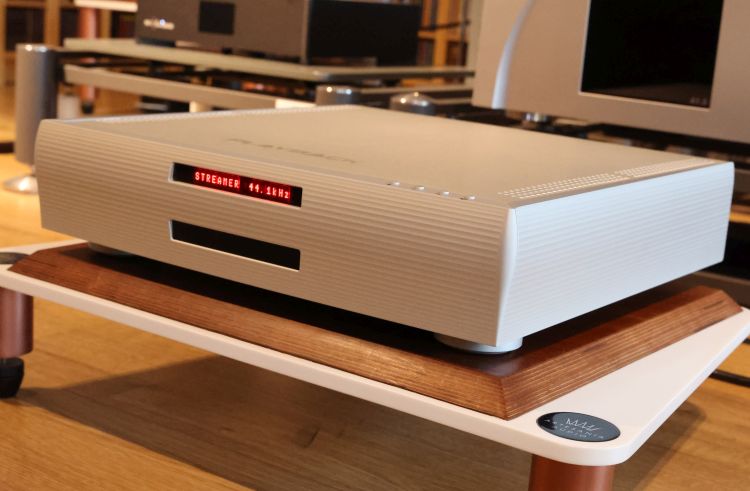
Review organized by Marc Loubeau / Prestige Audio Diffusion
Review sample provided by Prestige Audio Diffusion
Retail prices including VAT:
MPD-6: 17.990 euro
Stream-X2 option (UPnP & Roon Ready): 3.590 euro
About Playback Designs
For detailed information about founders Andreas Koch and Bert Vogt, the origin of Playback Designs, and the Edelweiss design philosophy, please see my earlier MPS-X review.
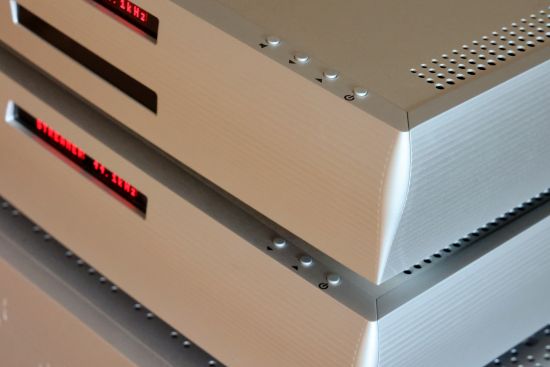
MPD-6 Description
The Playback Designs MPD-6 is a discrete DAC with integrated analog volume control. As part of the Edelweiss series, the MPD-6 has its roots in the Dream series from which it borrows key technologies and combines these with new ones to create a more compact and cost-effective package.
The MPD-6 can be operated in two different ways. First, it can be used standalone. For this setup, the DAC has five digital inputs (USB, PLINK, AES/EBU, Coax, and TosLink) to connect any digital source. The Playback Designs’ proprietary clock generator, jitter-eliminating, and buffering technology (PDFAS) clean up any digital input signal before subjecting it to the D/A process.
Second, the MPD-6 can be connected with the MPS-X digital source and streaming interface. In this mode, the MPS-X and MPD-6 are combined for the ultimate separation between digital and analog circuits and ultimate performance. In this mode, all the digital sources are no longer connected to the MPD-6 directly, but rather to the MPS-X digital interface which in turn is connected to the MPD-6 via the galvanically separated fiber optical PLINK interface. In this mode, all digital source signals actually pass the PDFAS clean-up and buffering mechanism twice: once in the MPS-X and a second time in the MPD-6. This results in even stronger clock signal integrity and sonic performance.
Connectivity
The MPD-6 has the following digital inputs: USB (PCM up to 384kHz, DSD up to 11.2MHz) AES/EBU (PCM up to 192kHz, DSD via DoP) S/PDIF on Coax (PCM up to 192kHz, DSD via DoP) TosLink (PCM up to 96kHz), and PLINK for all native sample rates. The only digital output is via PLINK, which accepts all rates natively. Analog outputs are available in fully differential XLR and single-ended RCA. Optionally, the Stream-X2 module can be added to the MPD-6 to enable full streaming audio support.
Stream-X2 Option
Stream-X2 is the successor of the older Stream-IF interface that was limited to 192kHz / DSD1x, whereas Stream-X2 supports sample rates up to 384kHz for PCM and 4x for DSD. This option enables a wide range of Playback Designs components to include very high-quality streaming over an RJ45 network connection for Tidal, Qobuz, Deezer, vTuner, NAS, and importantly, Roon.
Any DLNA/UPnP-compatible app should work with the Stream-X2 option but the best ones are the M-Connect Control HD app for iPad and Bubble UPnP for Android. With these apps, one can stream local library music as well as online streaming services such as Qobuz and Tidal. Alas, it seems Qobuz Connect is not supported as I did not succeed in streaming to the MPS-X directly from the Qobuz app.
Arguably the best user interface is provided by Roon which also supports both local libraries and streaming service music playback, which is then streamed to the MPS-X via Roon’s own RAAT protocol.
The Stream-X2 option is also available for the Edelweiss series MPS-6 CD/SACD player/DAC, as well as for the Dream Series MPT-8 Transport and MPS-8 CD/SACD player/DAC. The MPD-8 DAC is not able to be fitted with the internal Stream-X2 option. In that case, the Stream-X2 option must be installed into the MPT-8 Transport which should then ideally be connected to an MPD-8 using the proprietary PLINK. This will then transform the MPT-8 Transport into a universal CD/SACD/Streaming transport, capable of sending native DSD through PLINK. Alternatively, if one does not mind non-matched casing quality and colors, one can also use the standalone MPS-X in combination with an MPD-8.
The MPD-6 unit as reviewed here is fitted with the Stream-X2 option.
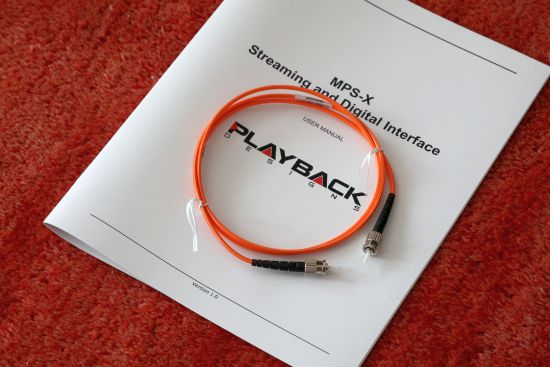
PLINK
PLINK is a variation on ST glass optical, specially adapted by Playback Designs to carry the delicate music signal from component to component whilst supporting all sample rates for PCM and DSD natively. PLINK is an optical format but it uses an entirely different interface than TOSLink. Instead of relying on a LED source, PLINK uses a high-quality, low-jitter, Laser ST fiber optic interface. This kind of interface is normally used for very high bandwidth communication links where receivers require an extremely low-jitter signal for reliable decoding. The music signal travels over PLINK using a much lower bandwidth protocol than the specified limit of the media, which further increases robustness against jitter. Cables for PLINK are specified for multimode, 62.5/125µm.
The first version of the PLINK interface was launched more than 15 years ago and supported DSD up to 5.6MHz. This version is called “Classic” and is implemented in the Playback Designs 5-series products and IPS-3 (unless they have been upgraded). As technology never sits still, the DSD sample rate has been expanded to 11.2MHz several years ago. Accordingly, Playback Designs also expanded the PLINK format and called it “Sonoma” reminiscent of its Sonoma workstation origin.
Interestingly, PLINK is compatible with NAGRA LINK. This means that the MPS-X Network Transport is compatible with NAGRA DACs that have a NAGRA Link input. And the same logic applies to the MPT-8 Transport. This is worth noting as there are currently no CD/SACD or Streamer Transports in the NAGRA catalog.
Power Supply
A critical part of any analog circuit is its power supply. All power supplies used in the Edelweiss Series products are proprietary-designed, built from the ground-up developments. Playback Designs applied the same principles again of separation by designing it with the lowest noise linear regulators and sparing no expense to achieve the highest performance and the most transient-friendly power for the analog output stage. The power supply is actually eight-in-one as it has 4×2 parallel circuits to help further separate individual power domains. It is driven by a transformer that is custom-built for Playback Designs with integrated Mu-metal shielding.
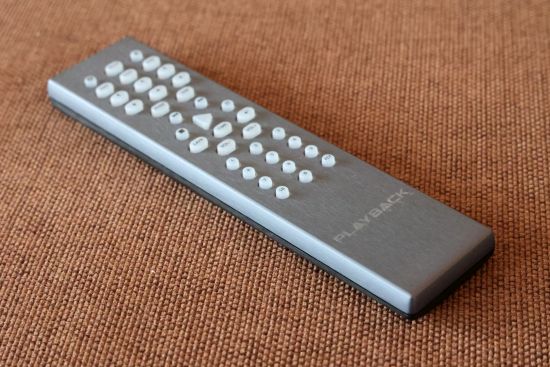
The MPD-6 comes with a beautifully sculpted full-metal IR remote control handset.
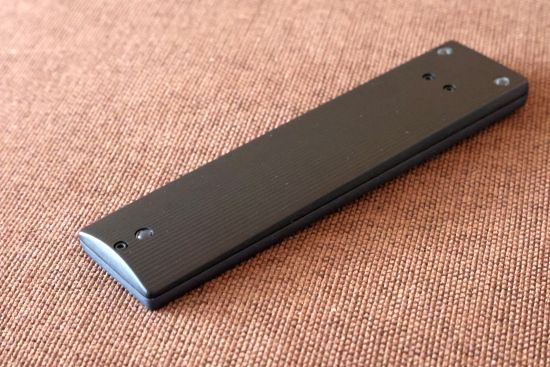
Separation
It is well known that the core D/A circuitry and its associated analog output stage are among the most sensitive links in the digital playback chain. They are susceptible to influences from clocked circuits (such as processors and displays), power supplies, and external sources connected via (galvanically coupled) copper cables. Only the slightest modulation of the digital sample clock will result in jitter which in turn can contribute to what audiophiles often describe as “digital” sound. Often, these subtle disturbances, especially related to clock jitter, are hard or even impossible to measure. Tedious listening tests with prototype circuits can help the designer in optimizing the general architecture and detailed circuit design and this is exactly what the Playback Designs team did. The separation of circuits that allows the music to blossom is what connects the Edelweiss design philosophy with the Edelweiss flower. It blossoms in isolation, high up in altitude in a pure surrounding where it is one with nature and is free to grow into the symbol of beauty, purity, strength, and perfection.
Clock Generation and the influence of Displays
Most available displays are driven by internal processors or refreshing circuits with simple built-in clock generators that run freely at frequencies that are not related or coupled to any audio sample rate. It is known that two independent clock generators within the same product that are not coupled or synchronized in any way, will „beat against each other“ and create inter-modulation distortion. This doesn‘t matter so much for the display clock, but it does very much for the audio sample clock. Therefore, it is Playback Designs‘ strict design rule to only use one single clock generator in the most critical element, the DAC. But this drastically limits the choice for the front panel display. Where many competing products use fancy graphic color displays, Playback Designs products use simpler displays that can be driven with an external clock that allows being synchronized with the audio sample rate.
The Edelweiss products use a single clock source to drive every circuit from the control processor to the signal processor, the digital input, and the display. The MPS-X is designed to allow multiple clock generators for the streamer, network bridge, etc. but it then re-clocks all digital signals through Playback Designs‘ proprietary high-precision clock generator before sending the signal out to the DAC via its fiber optical interface (PLINK). This prevents any inter-modulation effects from reaching the DAC and achieves the best possible separation between analog and digital circuits.
The MPS-6 and MPD-6 also allow an internal streaming option (Stream-X2), but Playback Designs have taken great care to separate this source from the analog circuit to minimize any negative intermodulation effects. For the audio sample clock, the company uses a proprietary generator designed to eliminate any correlated jitter that can negatively impact the sonic performance. This is one of the most critical technologies in a DAC, and Playback Designs is constantly innovating new algorithms on the same basic concept that was started already 20 years ago.
Digital processing and D-A Conversion
The Edelweiss Series DACs incorporate the same basic digital signal processing algorithms that made Playback Designs‘ earlier products famous all over the world. New frequency and time-based filters are working in concert to optimize performance during transients in the music signal, something the music signal is generally full of. According to Playback Designs, this helps bring out a level of performance of red-book CDs that is normally hidden when using conventional DAC chips and algorithms.
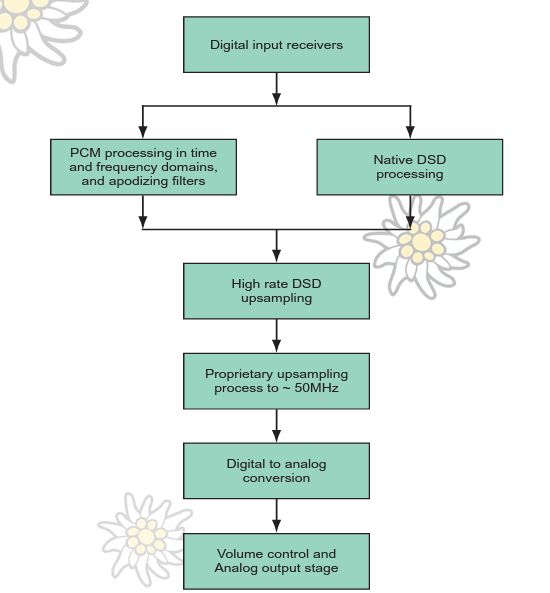
Additionally, an apodizing filter is used which can remedy some of the side effects caused by the A/D converter used in the studio during production. All PCM inputs are upsampled through this series of algorithms to a very high sample rate from where they are converted to DSD at an even higher sample rate. All DSD inputs are also upsampled to this intermediate sample rate. What follows is a proprietary digital process that further increases the bit rate of the signal to around 50MHz. To put this into perspective, most companies are upconverting 2, 4, or 8 times while Playback Designs are doing it 128 or 256 times.
At that point, the sample rate is so high that conversion to analog becomes quite trivial. But the significant advantage of this is not only a drastic simplification of the analog part of the DAC but also the prevention of any non-linear distortions that are common with most other DAC structures.
Discrete DAC
Relying on component manufacturers to solve signal processing challenges can end up in compromised performance. Therefore, Playback Designs embarked on a path to design a proprietary discrete solution. Standard chips for digital signal processing were considered not good enough and so the company uses gate arrays that can be programmed with their own discrete and proprietary algorithms.
2D DAC Technology
As Playback Designs puts it, audio is represented in an y/x-axis system: the (vertical) y-axis for amplitude and the (horizontal) x-axis for time, and digital audio was introduced mostly because of analog audio’s sensitivity problems in the (vertical) y-axis. However, as Playback Designs recognizes, digital audio not only quantizes the y-axis, but it also does so on the x-axis.
A typical state-of-the-art DAC converts between quantization levels in the digital y-axis and the analog y-axis and is completely transparent and open as to what happens on the x-axis (the time domain). As it follows, this lack of quantization on the x-axis forced us to treat digital audio signals as if they were analog. As end users, we use special cables, all kinds of mechanical devices for our CD players, power conditioners for digital audio, etc, in an attempt to shift the original problem from the y-axis to the x-axis, but the issues are still the same. Instead of interference or crosstalk, we now call it clock jitter.
Almost all DACs available today deal with the y-axis only and rely on external devices for the x-axis, such as complicated master/slave clock arrangements or external sync clock generators. According to Playback Designs, these devices are like band-aids on a wide-open wound deep inside the DAC. They help but do not truly resolve the problem at the source.
The Playback Designs solution is a 2-dimensional DAC that not only works on the y-axis but also on the x-axis. With this, the aim is to separate the digital world completely from the analog world and in doing so render any digital cable, transmission format, storage media, and application completely irrelevant to the final sonic performance. The only analog problems that we still have then are clock jitter that was inherent in the source created during recording, and the need for separation of the power supplies for digital and analog. And this is where the MPD-6 comes in.
Clock jitter from incoming digital audio signals can be described as an analog signal that gets mixed together with a quantized digital signal, which would be our ideal and constant sample rate clock. Before the start of any processing, these 2 components are brought into the same domain. The Playback Designs system quantizes the clock jitter into a digital signal, where it can be subtracted from the original sample rate while the latter is simultaneously converted to analog. Meanwhile, the DAC also works independently in the y-axis by using a set of unique algorithms in a completely discrete architecture. With this technology, all Playback Designs products separate their sensitive analog circuitry from the digital source and virtually eliminate any clock jitter caused by upstream cables and components.
User-Updateable
The architecture in Playback Designs products is programmable and user updateable. As new algorithms and technologies become available the user can immediately upload them into the product in form of a firmware upgrade.
Output Stage and Volume Control
The DAC’s analog output stage is designed with the finest components using 0.1% metal film resistors and film capacitors combined with the lowest noise precision impedance converters. The design for this was built from the ground up and features a true differential structure which means that one channel of audio is built out of two fully differential digital signals that are driven by an FPGA dedicated to the analog section only. The data transfer from the digital board to this FPGA is also differential and without any galvanic ground connections. Once again, the concept of separation and isolation is applied to the analog section of the DAC to achieve maximum performance.
The Edelweiss Series incorporates a very high-quality analog volume control which has been developed and refined over many years. This way, the output of the Edelweiss Series DAC can be adjusted to any level from zero to almost 25 volts peak in fine steps without compromising noise and distortion performance. This design is actually very similar to the Dream Series products, and if desired, the volume control can also be bypassed.
Next: Review Context








I’ll be honest: I didn’t understand if -apart from the “zero compromise factor”, and “cost-no object”- the DAC with the network card inserted and also used as preamplifier, sounds “worse” and how much “worse” than the same but inserted in series with a preamplifier and an external streamer. I’m sorry but I just couldn’t understand the long digression full of acronyms.
(Mea culpa)
Hi Luca, I re-read the review from a reader’s perspective and can understand the confusion with so many acronyms. I have now made a few little changes and additions to help clarify the points that I am trying to make. I trust the review will now read better!
Thank you Christiaan!
I’ll follow you 🙂
christian, did you ever use the MPD-6’s streaming function alone and not downstream of a dedicated streamer? if so, how did it hold up?
seems part of the value prop in uber-items like this is if they can replace other boxes (like the analog preamp feature does). —does the MPD-6s streamer by itself perform well enough to preclude an external streamer?
Yes, I did! The MPD-6’s Stream-X2 option is truly great. It’s just that the addition of the MPS-X makes it even better.
if a MPD-6 owner would get the MPS-X, do you think an external streamer (like the Grimm or Aurender, etc) would still be needed if you’re only streaming Qobuz?
I would say in that case a server is superfluous, unless you want to use Roon.
In that case, I would consider a server to be superfluous, unless you want to use Roon.
Hi there, thoughtful question here looking for a thoughtful response.
1. Do you think MPS-X + MPD6 beats K50 + MPD8? Former forms a great marriage but at expense of using a worse core as likely customer will just use desktop computer core not connected to MPS-X. Latter set up has better core being used and better DAC but at expense of a worse connection to DAC (no PLINK)
2. Do you think MPS-X + MPD8 using a roon core off computer desktop (computer not connected to the MPD-X directly but just used as roon core) beats K50 + MPS-8?
I really dislike the fact that the K50 player section not being used while adding the MPS-X between the K50 and MPD-6 in your review so trying to pick your brain.
Thank you much in advance.
Hi Frank, I cannot answer any of these questions as I have not yet heard the MPD8. That said, you can always opt for the Antipodes K41 as a server-only solution if you’re not going to use the K50’s player section.
Hi Christiaan, After just writing you a question regarding the MM Tambaqui in connection with the Aqua La Diva M2, I decided to check if you had written about the Tambaqui and saw you have. Circuitously, I then ended up here!:) The back story is that I have been thinking about replacing my Tambaqui with an MPD-6. Curious how you think they compare, at a very high level, and which you would personally prefer for overall musicality.
The MPD-6 is on a different level than the Tambaqui. Especially in terms of musicality indeed. The Tambaqui is really great, certainly at its price, but the MPD-6 is simply better. As well it should at its elevated price. Please note that I have also reviewed the Tambaqui by itself.
Very interesting. Thank you for your take. That is pretty impressive. I was also looking at the MPD-8, which I suppose would be another level up from there and would really leave the Tambaqui behind. Would be interesting to hear your take on the MPD-8 at some point, if you’re able to get a unit for review.
It’s possible that I will review the MPD-8 at some point, but nothing has been planned for this yet.
Thank you! Will certainly enjoy reading to an MPD-8 review should you ever write one.
Hi Christiaan, Sorry, another question regarding the MPD-6 in contrast with the MM Tambaqui: Is there anything you can comment in regards to:
1) How these contrast with one another in terms of soundstage height, width, depth, and the like?
2) Do you recall a noticeable difference in how fatiguing the two DACs are? I know neither is considered particularly fatiguing but still I’m curious if there is a difference.
Thank you again!
Tambaqui is more concentrated, MPD-6 is more spacious. I feel neiter are fatigueing indeed but since Tambaqui is crisper and more direct, one might find the MPD-6 relatively less fatiugueing.
Thank you so much! I agree with your reaction to the Tambaqui.
Hi Christiaan,
Quick update: I purchased an MPD-8 to compare with my Tambaqui and I do see what you mean in this review (even though the review is of the MPD-6). Even not broken in the MPD-8 has superior musicality and makes the Tambaqui sound a bit analytic by comparison. That said, I have not even neared the suggested burn-in point of 500 hours, so I won’t say any more until that occurs. Question: While I have an Aqua La Diva M2 arriving next week, I am now wondering whether Playback’s own transport, the MPT-8 might not be a better pairing with the MPD-8 since the Tambaqui seems very likely to go. Do you have any experience with the MPT?
Hi Ajaj, nice feedback, thanks. Alas, I have not heard the MPT-8 transport. I do hold the Aqua La Diva M2 in very high esteem and I’m sure it would pair very well. Would the MPT-8 pair even better? I really do not know. One might suspect so for a family member and connected via PLINK but the only real way to know is to try it in practice. Another thing to consider might be whether the MPT-8 would work as well standalone as the Aqua in combination with another brand of DAC. I’m sure it would do universally well but this might be worth checking if and when you have an MPT-8 at hand.
Thanks, Christiaan, You are right that it’s best to test it out first hand. Let me see if I can get a unit to test. Seems they’re harder to readily get a hold of than the DACs, but I will see.
BTW, it is interesting how spot on your reviews are. I have been comparing using the MPD-8 with and without preamp. After I made this comparison and noted the effect, I came back your MPD-6 review and your conclusion is nearly identical to what I heard.
Thanks for the nice feedback, Ajay!
Hi Christiaan, I continue to break-in my new MPD-8. You wrote here, “ With the MPD-6 used at a fixed output level and feeding the CH L1 analog preamp, the music is presented in a beautiful mix of effortless liquidity and truly excellent resolution, not bettered by any other DAC that I used, including the C1.2.”
Do you recall the voltage setting you used?
In the review, I noted: “While walking through the MPD-6’s available output level settings I found that the +3dB setting aligned it perfectly with the CH C1.2 DAC’s output, so I stuck with this.”
In general, I always recommend trying all output voltage options and simply siding with the one that sounds best in any given combination.
Thanks, Christiaan! Whoops, sorry, not sure how I missed that. I am currently finding 0db is the best. Will continue testing.
Hi Christiaan. As a result of your excellent reviews I bought the Aequo Stella Actives and Tambaqui DAC. After your MPD-6 review I replaced the DAC with the MPD-6 with X Stream board. I agree with your comment that as nice as the Tambaqui is the MPD-6 is on a different level. Today’s question: I would appreciate your thoughts on how the Grimm MU2 compares to the MPD-6. Regards Nick
Hi Nick, that’s a tough one as I don’t have them side by side. But I *think* the MPD with X Stream Board might perhaps be a little more expressive and lively, whereas the MU2 might perhaps be smoother or lusher.
Thanks Christiaan, much appreciated.
Hello Christiaan: In the context of your hi-fi system – and you were forced to choose – am I right in thinking that you personally prefer the sound of the Playback Designs MPD-6 over that of the Grimm Audio MU2?
I would personally prefer the MPD-6.
Thank you, Christiaan. I very much appreciate your feedback.